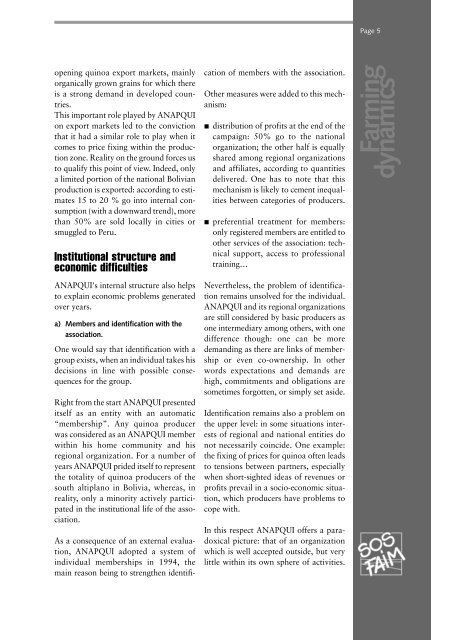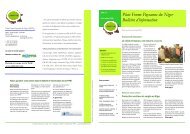ANAPQUI, a producer's experience with quinoa - SOS Faim
ANAPQUI, a producer's experience with quinoa - SOS Faim
ANAPQUI, a producer's experience with quinoa - SOS Faim
Create successful ePaper yourself
Turn your PDF publications into a flip-book with our unique Google optimized e-Paper software.
opening <strong>quinoa</strong> export markets, mainly<br />
organically grown grains for which there<br />
is a strong demand in developed countries.<br />
This important role played by <strong>ANAPQUI</strong><br />
on export markets led to the conviction<br />
that it had a similar role to play when it<br />
comes to price fixing <strong>with</strong>in the production<br />
zone. Reality on the ground forces us<br />
to qualify this point of view. Indeed, only<br />
a limited portion of the national Bolivian<br />
production is exported: according to estimates<br />
15 to 20 % go into internal consumption<br />
(<strong>with</strong> a downward trend), more<br />
than 50% are sold locally in cities or<br />
smuggled to Peru.<br />
Institutional structure and<br />
economic difficulties<br />
<strong>ANAPQUI</strong>'s internal structure also helps<br />
to explain economic problems generated<br />
over years.<br />
a) Members and identification <strong>with</strong> the<br />
association.<br />
One would say that identification <strong>with</strong> a<br />
group exists, when an individual takes his<br />
decisions in line <strong>with</strong> possible consequences<br />
for the group.<br />
Right from the start <strong>ANAPQUI</strong> presented<br />
itself as an entity <strong>with</strong> an automatic<br />
“membership”. Any <strong>quinoa</strong> producer<br />
was considered as an <strong>ANAPQUI</strong> member<br />
<strong>with</strong>in his home community and his<br />
regional organization. For a number of<br />
years <strong>ANAPQUI</strong> prided itself to represent<br />
the totality of <strong>quinoa</strong> producers of the<br />
south altiplano in Bolivia, whereas, in<br />
reality, only a minority actively participated<br />
in the institutional life of the association.<br />
As a consequence of an external evaluation,<br />
<strong>ANAPQUI</strong> adopted a system of<br />
individual memberships in 1994, the<br />
main reason being to strengthen identifi-<br />
cation of members <strong>with</strong> the association.<br />
Other measures were added to this mechanism:<br />
distribution of profits at the end of the<br />
campaign: 50% go to the national<br />
organization; the other half is equally<br />
shared among regional organizations<br />
and affiliates, according to quantities<br />
delivered. One has to note that this<br />
mechanism is likely to cement inequalities<br />
between categories of producers.<br />
preferential treatment for members:<br />
only registered members are entitled to<br />
other services of the association: technical<br />
support, access to professional<br />
training…<br />
Nevertheless, the problem of identification<br />
remains unsolved for the individual.<br />
<strong>ANAPQUI</strong> and its regional organizations<br />
are still considered by basic producers as<br />
one intermediary among others, <strong>with</strong> one<br />
difference though: one can be more<br />
demanding as there are links of membership<br />
or even co-ownership. In other<br />
words expectations and demands are<br />
high, commitments and obligations are<br />
sometimes forgotten, or simply set aside.<br />
Identification remains also a problem on<br />
the upper level: in some situations interests<br />
of regional and national entities do<br />
not necessarily coincide. One example:<br />
the fixing of prices for <strong>quinoa</strong> often leads<br />
to tensions between partners, especially<br />
when short-sighted ideas of revenues or<br />
profits prevail in a socio-economic situation,<br />
which producers have problems to<br />
cope <strong>with</strong>.<br />
In this respect <strong>ANAPQUI</strong> offers a paradoxical<br />
picture: that of an organization<br />
which is well accepted outside, but very<br />
little <strong>with</strong>in its own sphere of activities.<br />
Page 5<br />
Farming<br />
dynamıcs



